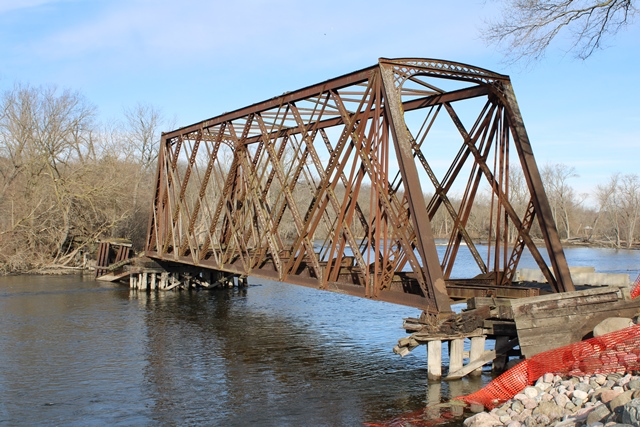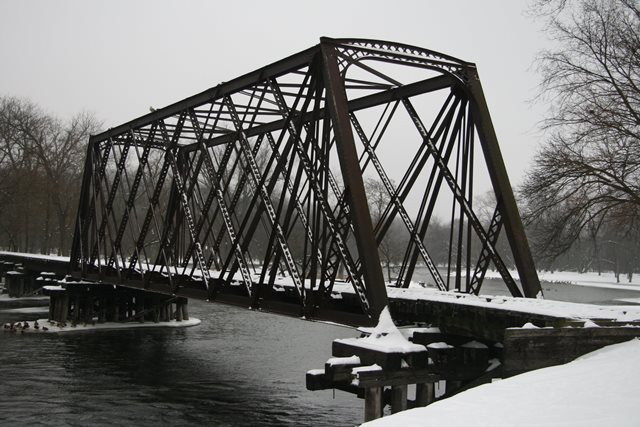We Recommend:
Bach Steel - Experts at historic truss bridge restoration.
BridgeHunter.com Phase 1 is released to the public! - Visit Now
Carpentersville Railroad Bridge

Primary Photographer(s): Nathan Holth and Rick McOmber
Bridge Documented: January 22, 2012, July 31, 2015, and October 18, 2021
Carpentersville: Kane County, Illinois: United States
Metal 9 Panel Rivet-Connected Lattice (Quadruple Warren) Through Truss, Fixed and Approach Spans: Metal Stringer (Multi-Beam), Fixed
1879 By Builder/Contractor: Leighton Bridge and Iron Works of Rochester, New York
1924
105.0 Feet (32 Meters)
615.0 Feet (187.5 Meters)
Not Available
1 Main Span(s)
Not Applicable

View Information About HSR Ratings
Bridge Documentation
This bridge no longer exists!
Bridge Status: Bridge Status: This nationally significant bridge and iconic city landmark was demolished February 2024 under the sole direction and support of Otto Engineering and President and CEO Tom Roeser!This bridge's song is:
Bridge Overview
This bridge is an extremely old example of a lattice truss bridge, and has been abandoned, with some of the short-span and not historically significant approach spans having collapsed. The exact history of this bridge is not known, but it is a ca. 1879 lattice truss and possible work taking place in 1924. The ca. 1879 lattice truss retains excellent historic integrity. It is highly significant as an early example of an uncommon truss type, and also as an early rivet-connected truss bridge. The bridge is today owned by Otto Engineering. The future of the bridge is uncertain. A field visit in 2021 shows that the 1879 truss span is in imminent danger of complete collapse due to failure of a timber substructure. The truss itself remains in good condition and if removed prior to collapse could be reused and preserved for pedestrian use with minimal repairs.
It is believed the span was originally constructed in Wisconsin or Minnesota, before being moved to a crossing of the White River near Glen, Nebraska. It is unknown when the move occurred, or if it was moved before. In 1924, the truss was moved here. See John Marvig's website for more information.
Otto Engineering and the City of Carpentersville: The Shame of Illinois and Chicagoland
When HistoricBridges.org visited this bridge they found a unique contrast in Carpentersville. Here was a city unlike most in Chicagoland with a downtown populated by these really beautiful historic industrial buildings that are somewhat uncommon in the Midwest particularly in a large cluster as they are found in this city. In many ways these buildings almost gave the downtown area a New England feel to it where this industrial architecture is more common still. Signs clearly indicated that most of these buildings were owned by Otto Engineering, and it would seem that perhaps this is a unique historical city with a company that cherishes the community's heritage and has preserved all these buildings. Then we arrived at the bridge. A railroad bridge with statewide, and national significance due to its pristine lack of deterioration and alteration. The truss span that is. It was sitting on non-original timber substructure of no significance that was going to tip the bridge over eventually. The solution here was so obvious it screamed out loud: Pick this bridge off the timber and set it on the ground. Either leave it on the ground as an exhibit or move and reuse it elsewhere. It hardly needed any repairs at all do to the unsurpassed quality of the iron.
Even the commuity saw the value of the bridge, starting a petition to save the bridge (PDF ARCHIVE). Neither the city of Carpentersville or Otto Engineer ever even was willing to start a conversation about preservation. Instead they spend over a million dollars to wipe this bridge off the face of the earth in February 2024! Note that Otto Engineering is one of the largest private companies in Chicagoland and the company's 2016 revenue was reported at $95.3 Million.Saving this historic bridge would have cost pocket change to a company of this size, and indeed would not have cost that much more than the demolition cost, assuming the bridge was simply set on the ground as an exhibit.
It is in moments like this that you see the true colors of a company like Otto Engineering. They really don't care about the community or its heritage. Guaranteed, any past acts of preservation this company may have done there was something "in it" for the benefit of the company. But when it came to something like this bridge, something that really mattered, a unique bridge of high significance, but no apparant profit path for the company... to the dumpster with history! Although its actually worse than this, because even this line of thinking does not make sense and it shows how braindead and stupid Otto Engineering really is. This bridge could have had obvious benefits for the company. There are many ways the preservation of a bridge like this could have been a benefit to the company. Relocated and preserved in a new location it could have improved the company's public relations as contributing to the vibrancy of the community for example. Or left as an exhibit it still would have shown a company that cares. People might have liked to take photos in front of the bridge for example, with the historic buildings nearby, it creates a beautiful scene of industrial heritage. Indeed the bridge and the buildings went together so beautifully to remove the bridge does harm to the overall historic district feeling of the community, and as such Otto Engineering basically shot itself in its foot, tearing a part of a bridge that contributes to the unique historic feel of the area including the buildings that Otto itself owns and uses. Otto Engineering is a short-sighted and hypocrtical company that failed to see its potential contribution to the city it is a part of. It shows a total lack of harmony between the company and the community, which is sad to see.
So when you drive through Carpentersville and you see all those beautiful historic buildings and all those Otto Engineering banners, do not be deceived by the propaganda. When it really came time to save a unique piece of history in Carpentersville, when that act of saving did not have any percieved benefit to Otto Engineering, they showed their true colors, like so many American corporations, and showed a total lack of concern for the city, its people, and its heritage.
This bridge is tagged with the following special condition(s): Unorganized Photos
![]()
Photo Galleries and Videos: Carpentersville Railroad Bridge
Bridge Photo-Documentation
Original / Full Size PhotosA collection of overview and detail photos. This gallery offers photos in the highest available resolution and file size in a touch-friendly popup viewer.
Alternatively, Browse Without Using Viewer
![]()
Bridge Photo-Documentation
Mobile Optimized PhotosA collection of overview and detail photos. This gallery features data-friendly, fast-loading photos in a touch-friendly popup viewer.
Alternatively, Browse Without Using Viewer
![]()
Additional Unorganized Photos
Original / Full Size PhotosA supplemental collection of photos that are from additional visit(s) to the bridge and have not been organized or captioned. This gallery offers photos in the highest available resolution and file size in a touch-friendly popup viewer.
Alternatively, Browse Without Using Viewer
![]()
Additional Unorganized Photos
Mobile Optimized PhotosA supplemental collection of photos that are from additional visit(s) to the bridge and have not been organized or captioned. This gallery features data-friendly, fast-loading photos in a touch-friendly popup viewer.
Alternatively, Browse Without Using Viewer
![]()

John Marvig Photos, Unorganized
Original / Full Size PhotosA supplemental collection of photos that are from additional visit(s) to the bridge and have not been organized or captioned. Includes demolition photos. This gallery offers photos in the highest available resolution and file size in a touch-friendly popup viewer.
Alternatively, Browse Without Using Viewer
![]()
John Marvig Photos, Unorganized
Mobile Optimized PhotosA supplemental collection of photos that are from additional visit(s) to the bridge and have not been organized or captioned. Includes demolition photos. This gallery features data-friendly, fast-loading photos in a touch-friendly popup viewer.
Alternatively, Browse Without Using Viewer
![]()
Maps and Links: Carpentersville Railroad Bridge
This historic bridge has been demolished. This map is shown for reference purposes only.
Coordinates (Latitude, Longitude):
Search For Additional Bridge Listings:
Bridgehunter.com: View listed bridges within 0.5 miles (0.8 kilometers) of this bridge.
Bridgehunter.com: View listed bridges within 10 miles (16 kilometers) of this bridge.
Additional Maps:
Google Streetview (If Available)
GeoHack (Additional Links and Coordinates)
Apple Maps (Via DuckDuckGo Search)
Apple Maps (Apple devices only)
Android: Open Location In Your Map or GPS App
Flickr Gallery (Find Nearby Photos)
Wikimedia Commons (Find Nearby Photos)
Directions Via Sygic For Android
Directions Via Sygic For iOS and Android Dolphin Browser
USGS National Map (United States Only)
Historical USGS Topo Maps (United States Only)
Historic Aerials (United States Only)
CalTopo Maps (United States Only)


